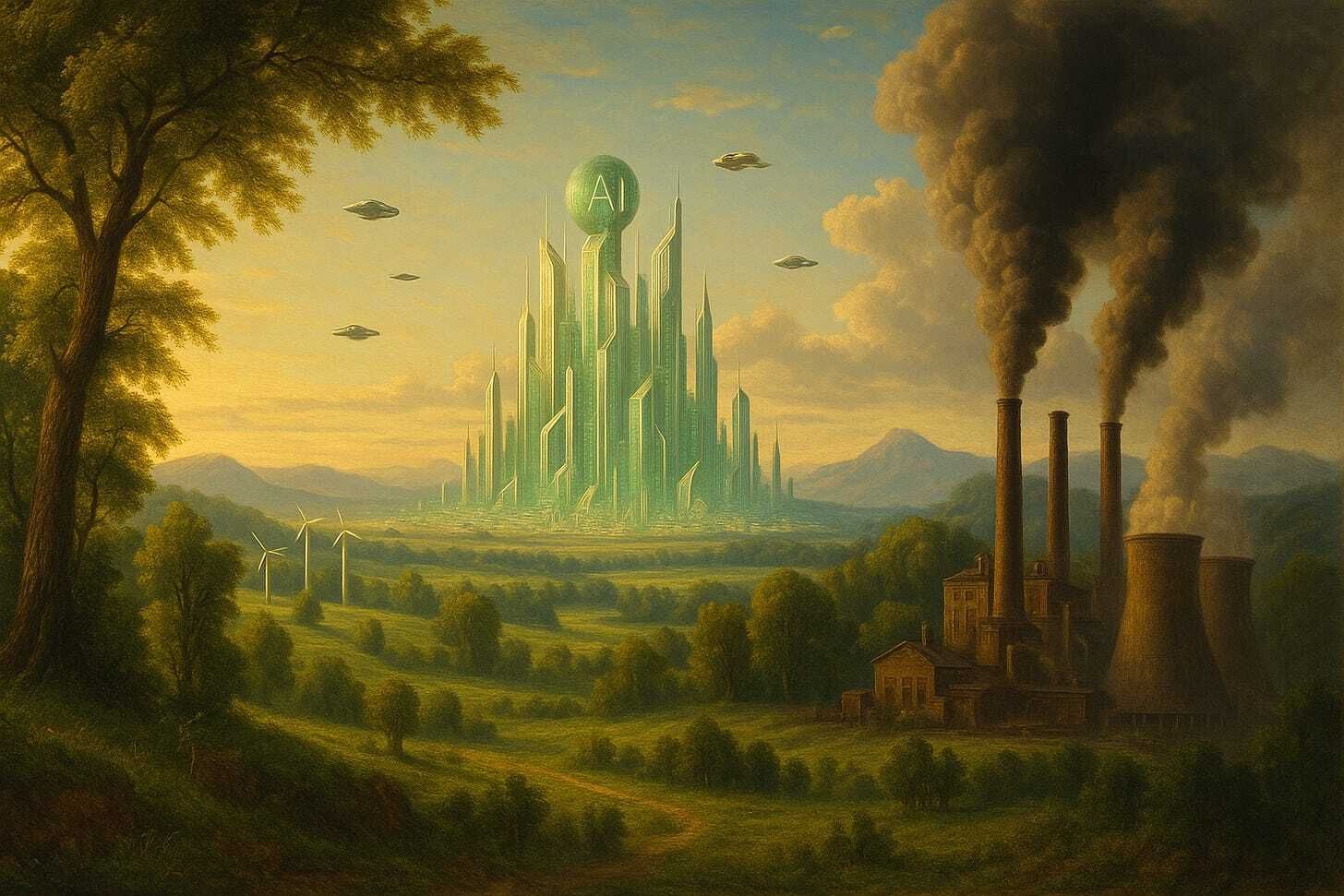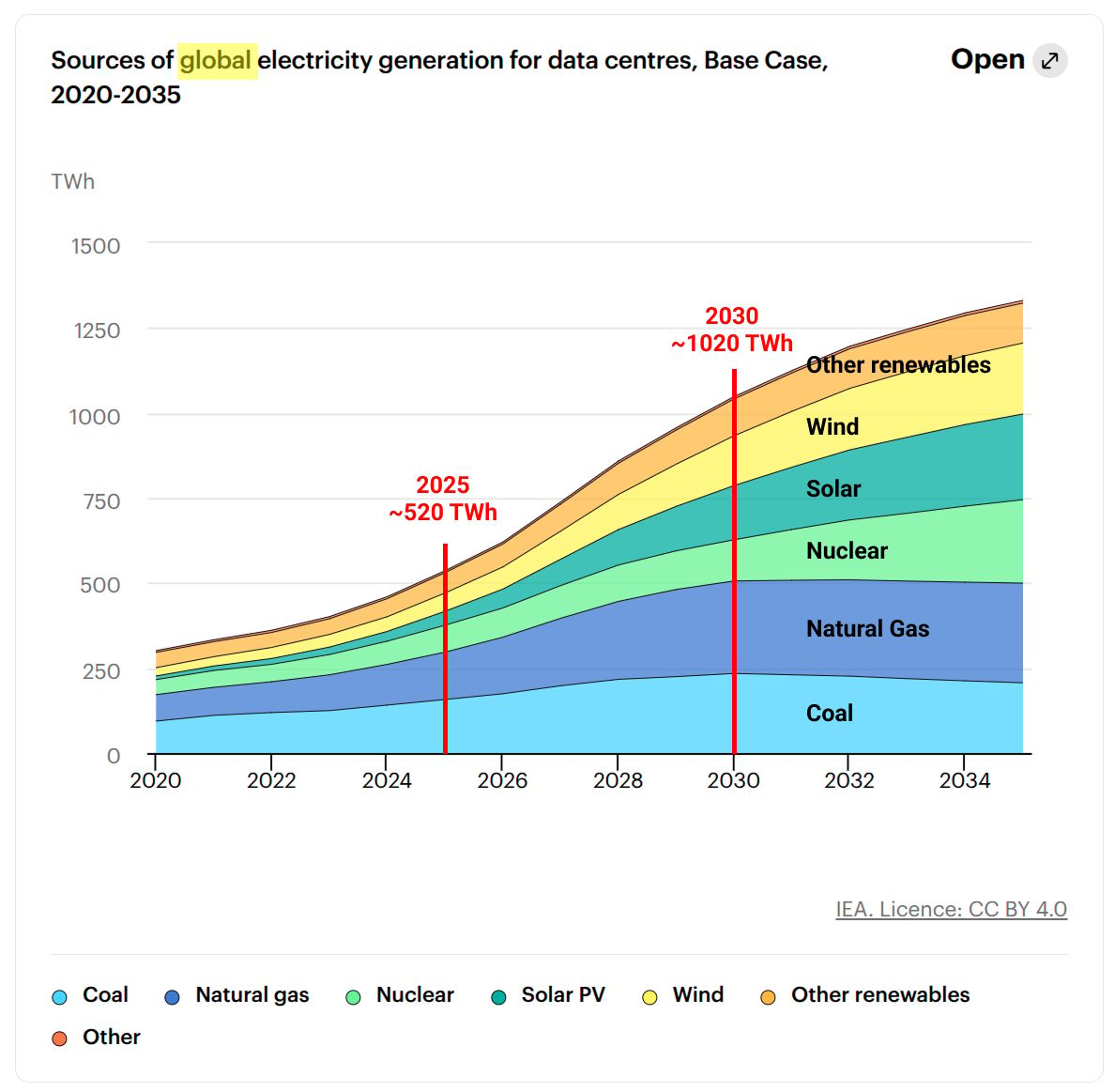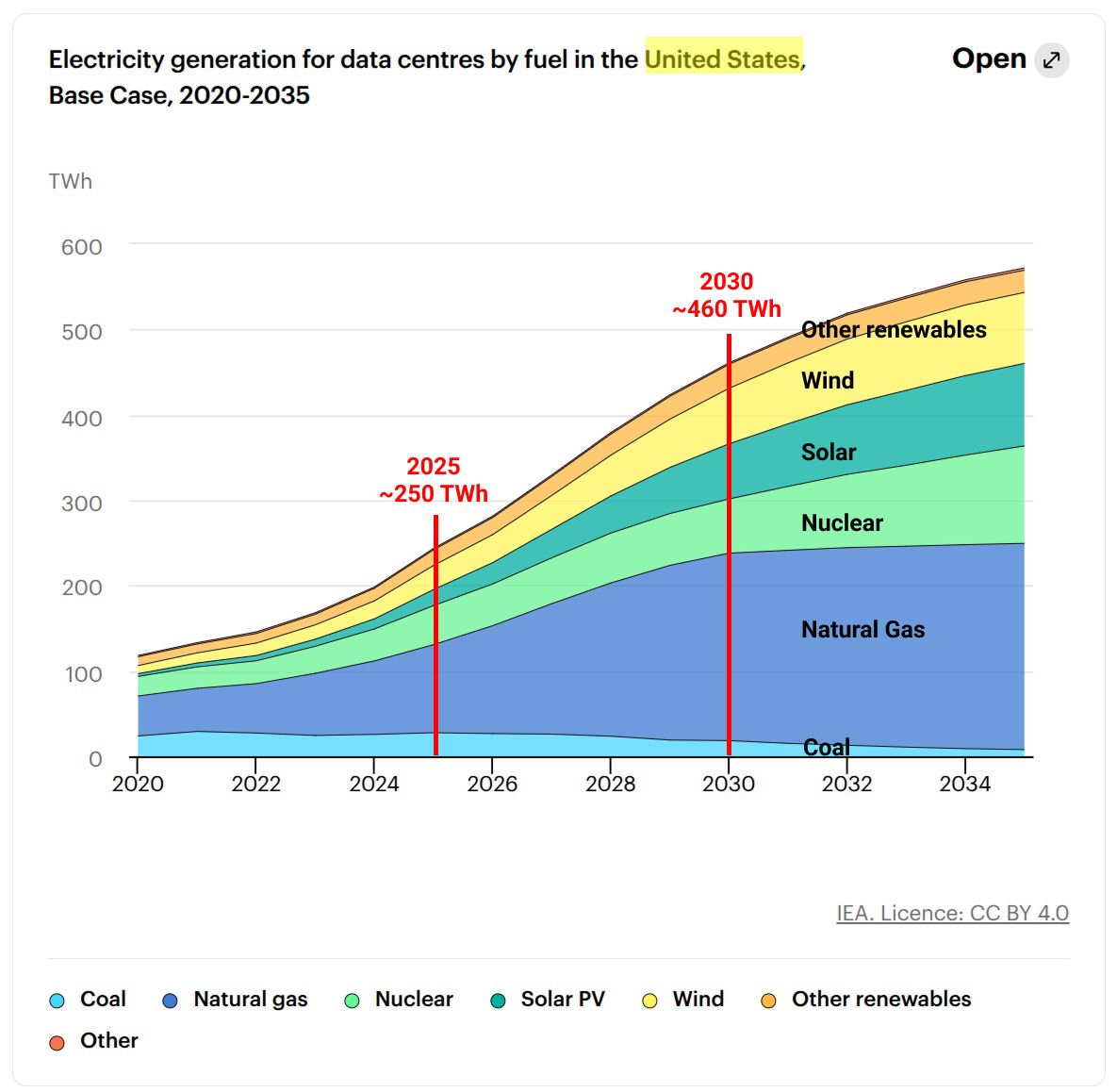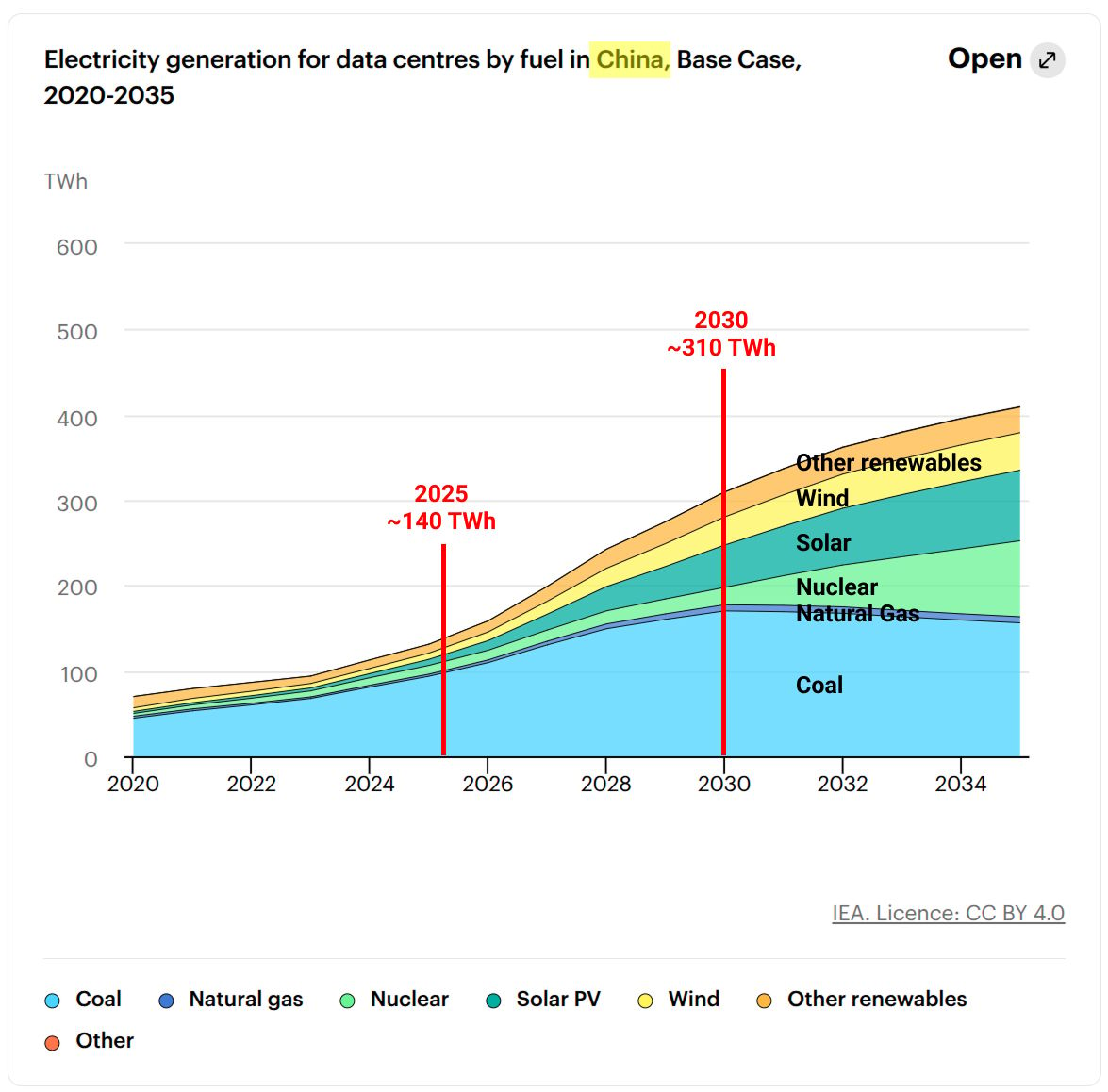Good morning!
Welcome to The Daily Grind for Thursday, August 7.
Today’s One Headline continues to look at AI’s potential as a catalyst for an energy revolution. The current outlook is a little more mixed than what optimists (like me) would hope.
Next, we’ll preview One Page of a new book on the incredible rise of solar power.
Finally, our One Question will investigate what gives us energy, and what zaps it.
Let’s get started!
📰 One Headline: A Closer Look at AI’s Green Energy Revolution

Yesterday, the Financial Times reported on a formerly decommissioned coal plant in Homer, Pennsylvania being re-ignited as a gas-powered facility. At 4.5 gigawatts (GW) of capacity, it will become the largest gas plant in the United States.
The reason, in part, is the rapidly-growing energy demands of data centers to power AI.
The Homer plan is huge. For comparison, it will produce roughly the same amount of energy as the largest nuclear plant in the United States: the four-reactor Plant Vogtle in Georgia.
But why are energy companies still spinning up fossil fuel plants? Wasn’t AI going to lead to a green energy revolution?
Maybe, but not yet.
Renewable energy, in the short term, is not keeping up with the rapidly growing demand for always-on, reliable power.
Mike Hemsley, deputy director at the Energy Transitions Commission think-tank, said: “AI needs a spiky profile while doing deep learning,” which means powering a data centre using clean energy is still a purely “theoretical” idea. Data centres are “scrambling for gas turbines because that’s the most obvious choice”, he added.
The Future of AI and Energy
The International Energy Agency (IEA) published a report in April about the impact of AI on our energy needs, particularly for data centers.
The Takeaway: Renewable energy, including nuclear, is set to supply half of all data center energy by 2030. But the demand for data center energy is set to nearly double at the same time.
That means the demand for fossil fuels, like coal and natural gas, will continue to rise as well—at least until 2030.

The full story is more nuanced.
At a regional level, the energy supply charts look very different for the world’s two largest data center hubs—the United States and China:


China is massively reliant on coal, which will continue at least through 2023, according to the IEA. The United States is all but eliminating coal from its energy mix, replaced largely by natural gas, which is a cleaner fuel, though not considered “low emission.”
The most surprising part of this data is nuclear’s limited role in China’s energy mix. China is the world’s most active builder of nuclear power by far, with 32 plants in development, 39 planned, and 154 proposed. The second closest country is Russia, with 7 plants in development. The United States has zero.
This underscores the challenge with nuclear: even in the most pro-nuclear countries, it still take a long time to build.
Compare this to gas-powered plants. The Homer facility, officially announced three months ago, will begin delivering power by 2026 and producing its own power by 2027. The Vogtle Plant in Georgia has been in development (on and off) since the 1980s.
Plus, according to the developers, the gas-powered plant will produce 60% fewer emissions than the coal plant it is replacing.
So while nuclear is the best long-term option for renewable energy, it will take a decade or more to expand its capacity.
Wind and solar power, meanwhile, are becoming exponentially more efficient, but they are bottlenecked by battery capacity (which is also improving, but not as quickly).
In the meantime, the AI boom is not going to slow down and wait for renewable energy to catch up. It will forge ahead, pushing for fossil fuel energy capacity, with the biggest perpetuator of climate change being China’s coal industry.
🔗 A Few Good Links
Here are more stories to explore, including many follow-ups on recent headlines:
A Cheeky Pint: Stripe’s John Collison talks with Anthropic’s Dario Amodei
📚 One Page: Here Comes the Sun by Bill McKibben
Take IEA’s projections with a grain of salt. Renewable energy has consistently outpaced projections. According to environmentalist Bill McKibben, the IEA’s 5-year forecasts for renewable energy have missed by an average of 245%.
In his new book, Here Comes the Sun, McKibben shares the history and progress of solar power’s incredible rise in recent years—and the policies that could stifle its promise.
Here’s an excerpt from this book, which comes out on August 19. You can read a longer excerpt in The New Yorker:
There is a chance for a deep reordering of the earth’s power systems, in every sense of the word “power,” offering a plausible check to not only the climate crisis but to autocracy. Instead of relying on scattered deposits of fossil fuel—the control of which has largely defined geopolitics for more than a century—we are moving rapidly toward a reliance on diffuse but ubiquitous sources of supply. The sun and the wind are available everywhere, and they complement each other well; when sunlight diminishes in the northern latitudes at the approach of winter, the winds pick up. This energy is impossible to hoard and difficult to fight wars over. If you’re interested in abundance, the sun beams tens of thousands of times more energy at the earth than we currently need. Paradigm shifts like this don’t come along often: the Industrial Revolution, the computer revolution. But, when they do, they change the world in profound and unpredictable ways.
In fact, the sheer scope of that potential change seems to be motivating much of the current backlash against clean energy in the U.S. Donald Trump’s “Big Beautiful Bill” is disconcerting on many fronts but none more so than in its attempt to repeal the energy future by ending the I.R.A. credits for solar panels and E.V.s; it has already put a serious crimp in what six months ago was a fast-developing domestic solar industry. (The stock price for Sunrun, the country’s biggest residential-solar developer, fell forty per cent on a single day in June, after a new version of the Senate bill cut tax credits even more dramatically than expected.) An analysis from the Rhodium Group think tank found that by 2035 the bill may have eliminated as much as seventy-two per cent of all the clean electricity that would have been produced in the U.S. under the current law. But, in a way, even this backlash is a backhanded recognition of the moment; the Administration, and its supporters in the fossil-fuel industry, clearly consider this the last possible moment to stifle the sun.
❓ One Question: What gives you energy?
Energy is the lifeblood of society, but also our individual lives.
It’s easy to get stuck in a routine without questioning how or why you’re doing things. So ask yourself:
What are three things that gave me energy this week?
What are three things that sucked my energy?
If you’re struggling to recall, try journaling on this throughout the day today. Once you complete a task, ask yourself, did this give me energy (I.e., could I keep doing this again and again?), or did it drain me?
🗳️ Wrap Up and Feedback:
That’s it for today. Thank you to everyone reading and sharing The Daily Grind.
303 people read one newsletter in the last seven days, up from 276 a few weeks ago. Thank you 🙏🙏🙏
As always, your feedback is extremely helpful!